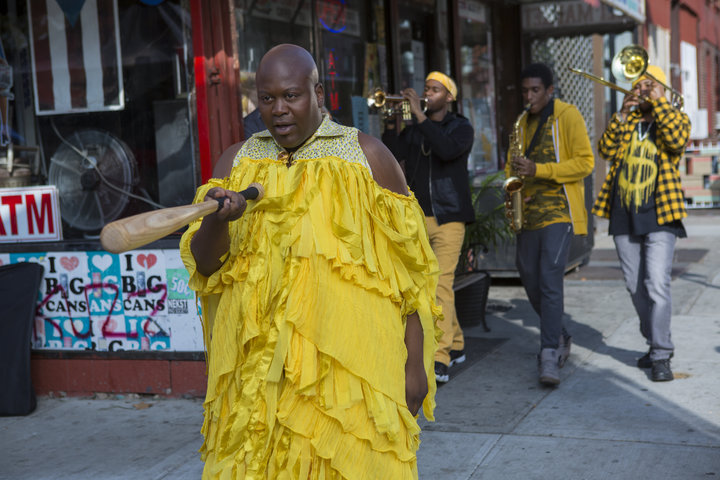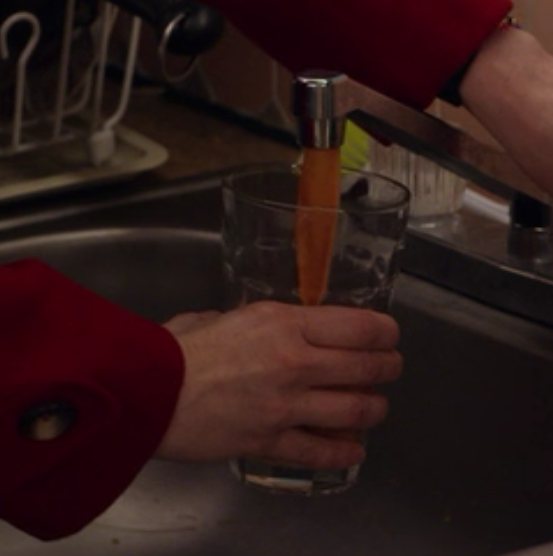
Gentrification and Unbreakable Kimmy Schmidt
Have you watched the latest season of Unbreakable Kimmy Schmidt? If not, go watch it. Much like the first two seasons of the show, season three excelled when it came to visual gags, outlandish plots, and all the weirdness Tina Fey wanted to put into 30 Rock but couldn’t get away with in a prime-time network TV comedy.
Early in the season, fancy-white-lady-looking-for-a-cause Jacqueline White announces that she’ll be fighting for improved water infrastructure in East Dogmouth, the neighborhood where Kimmy, roommate Titus, and landlord Lillian live. In response, Lillian decides to run for city council in order to oppose the plan, thinking that any improved infrastructure in the neighborhood will lead to gentrification and rising rents. Throughout each season of the series so far, gentrification has been a major theme. From Lillian chaining herself to prevent the construction of luxury apartments, to Titus ruing the conversion of yet another local establishment’s transition to a VAPE SHOP, to the hipsters visiting from Austin (NOT from Texas, as they assure us), the specter of gentrification haunts East Dogmouth:
For the most part, the portrayal of the evils of gentrification was pretty expected in seasons one and two. By focusing on how gentrification raises rents, leads to displacement, and changes the calculus on what establishments can remain profitable in the neighborhood, the series parroted back the party line: gentrification bad, exclusion of new residents bad.
In season three, though, the series actually starts to pay attention to just how thorny questions of gentrification and public investment actually are. Does a sitcom need to dive into the intricacies of urban policy? Of course not. But the fact Kimmy Schmidt decided to highlight the nuances of the discussion in a more thoughtful way than most of the press is able to is just one more reason to love it.
In this season, the writers weren’t afraid to draw attention to the inherent contradictions in Lillian’s adamant refusal to let the city invest in water infrastructure in the neighborhood. She screams that if faucets produce anything other than sludge for the first 30 seconds after being turned on that demand will skyrocket and they’ll all be out of a house (never mind the fact that, as a landlord, she would actually be likely to profit from any influx in gentrification).

After being elected to the council (turns out Kimmy is the only registered voter in the district), Lillian fights against the expansion of Whole Foods-esque “Big Naturals” into the neighborhood for the same reason. Lillian falls for the narrative that I called out a few months ago: if the best way to “care” for low income communities in our cities is to curtail public investment and make their neighborhoods so crummy that no one with money wants to live in them, we’ve failed them. Lillian’s frustration is real, and her fears aren’t ungrounded. Absent other city policy, improvements in infrastructure are likely to raise demand and rents.
Lillian’s response (refusal of public investment) is one of three responses, and unquestionably the worst. The other two responses also fail on their own: some say that strong rent protection is the only way to go, because that will ensure that the existing community will be able to afford to live there. Others say that removing all building restrictions and allowing the market to provide enough supply to match the increase in demand is the only way in the long run to ensure that prices don’t spiral out of control. Of course, strong rent controls inevitably lead to the convictions of landlords who illegally shut off heat and hot water in order to get residents to “voluntarily” surrender their protected units, and market rate development can leave the local community in its rear view window. Both approaches are necessary together, and we need to frankly recognize the limitations of each. What is undeniable, however, is that public investment without any sort of support for the local community can be deeply destabilizing.
Season three of Kimmy Schmidt really hits its gentrification-is-a-tough-problem in the episode where Titus gets scurvy (it’s a long story). Lillian and Titus scour the neighborhood in search of some citrus – any citrus will do (“Is it weird that we have to buy our food from a place that also sells Jason masks and loose hamsters?”, Titus asks). They go to bodega after bodega, unable to find fresh produce anywhere in the area. They finally head outside to a neighboring area to a Big Naturals location – where they run into Lillian’s nemesis, the owner who is trying to open the new location in East Dogmouth. When he asks why they’re there, Lillian tells him that they couldn’t find fresh food in their neighborhood. The Big Natural owner responds by explaining to Lillian that East Dogmouth is a food desert (as far as I know, the first time that phrase has ever been used in a sitcom) and explains that he wants to open a location there in order to bring fresh food to the neighborhood. “I’m just trying to turn a condemned chicken slaughterhouse into a grocery store,” he tells us.
Kimmy Schmidt makes a surprisingly thoughtful point here: when neighborhoods start to change, a higher-income population can support businesses that the established community isn’t able to alone. This can have negative consequences when the locally owned store goes owner, or a beloved food joint goes unpatronized by newcomers and loses its lease. It can, however, also be a boon by, in this case, bringing such amenities as fresh food. Demand in a neighborhood can often surge after new public investments such as water infrastructure, but increased amenities can also follow newcomers into previously underserved areas. If the city can provide stability for the existing community, it’s not immediately clear whether gentrification is good or bad. Some things improve, others are lost.
Neighborhood change and neighborhood amenities (both privately and publicly provided) are complicated and messy. It’s impossible to know how all the different factors will combine in a given area, and it’s important to remember that introducing higher-income residents into a neighborhood can bring serious benefits to everyone living their along with the often-discussed negative impacts. Unbreakable Kimmy Schmidt does a great job of bringing the nuances of the trade-offs to light through a popular show, and deserves great credit for that.